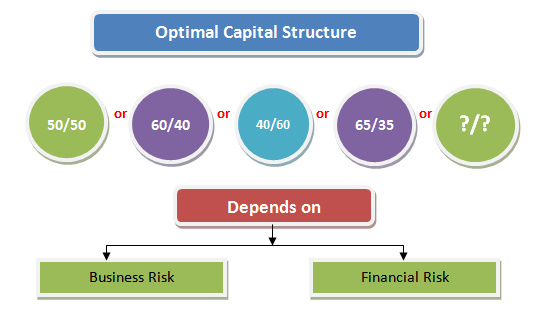How to Determine Optimal Capital Structure
Many people get confused about the optimal capital structure for a company because they observed that different companies holding different capital structures. Capital can be formed by using only equity or combination of debt and equity, but cannot form only using debt capital. For a company debt and equity can be 50/50, for other company it can be 40/60, or 60/40, or 65/35 or any other proportion. Here question may arise that what proportion of debt and equity should use to form an optimal capital structure?
The optimal capital structure mainly depends on the two important things. These are:
- The business risk related to the company’s business and
- The financial risk of that company
Business Risk
Business risk arises when a company unable to generate a sufficient amount of cash flow to pay off its operating expenditures. Operating expenditure can be rent expense, salaries expense, wages, depreciation, etc. The main thing is if the business unable to cover its business operation related expenditure then the company will exercise business risk. Lower the cash inflow, the higher the business risk and higher cash inflow from the operation will reduce the business risk.
So when forming an optimal capital structure it is required to keep in mind that the number of business risks that may arise. If there is a possibility of higher business risk then it will be a wise decision to use higher equity capital rather than using debt capital. On the other hand, the company which generates a huge amount of cash flow from its business operation can use a larger amount of debt to maximize its return.
Business risk can be divided into two risk categories. One is systematic (non-diversifiable) and the other is an unsystematic (diversifiable) risk. As we cannot reduce the systematic we must diversify our investment so that we can reduce the risk of the company.
Financial Risk
Financial risk directly related to the interest amount payable to the debt provider. That is when a company is unable to generate sufficient cash flow to pay off the financial obligations properly then that company experiences financial risk. A company with a sound financial position ensures less financial risk and the cost of debt financing is lower as the investment in this company is less risky.
Although business risk and financial risk are two broad things we have to keep in mind that some other factors like availability of equity capital, cost of equity, cost of debt, cash conversion cycle of the business, the profitability of the firm and corporate tax rate may involve with determining the optimal capital structure. Also, the optimal capital structure (debt and equity ratio) depends on the type of business and economic condition of the company.




Easy and Nice writing
tnx
thank you, good read.